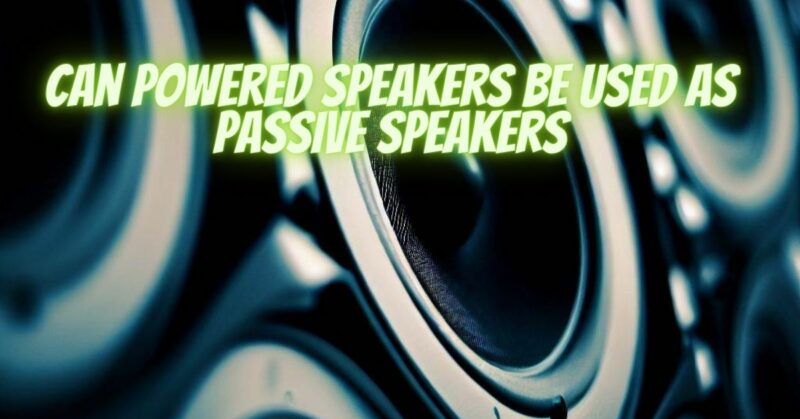Powered speakers, also known as active speakers, are designed with built-in amplifiers to provide a self-contained audio solution. On the other hand, passive speakers require an external amplifier to power them. A common question that arises is whether powered speakers can be used as passive speakers. In this article, we will explore the differences between powered and passive speakers and discuss the limitations of using powered speakers as passive speakers.
Understanding Powered and Passive Speakers: Powered Speakers: Powered speakers incorporate built-in amplifiers, allowing them to receive line-level signals directly from audio sources and independently power the speaker drivers. The amplifiers within powered speakers are designed to match the speaker components and optimize the audio performance.
Passive Speakers: Passive speakers, on the other hand, do not have built-in amplifiers. They require an external amplifier to provide power to the speaker drivers. Passive speakers receive a low-level audio signal from an amplifier and rely on it to amplify and distribute the audio signal to the drivers.
Differences between Powered and Passive Speakers:
- Amplification: The most significant difference between powered and passive speakers is the presence or absence of built-in amplifiers. Powered speakers have amplifiers integrated into the speaker enclosures, while passive speakers require an external amplifier for power.
- Convenience: Powered speakers offer convenience as they eliminate the need for a separate amplifier. They are self-contained units that only require an audio source to function. Passive speakers, on the other hand, require an additional amplifier, which adds complexity to the audio setup.
- Flexibility: Passive speakers provide greater flexibility in terms of amplifier choice. With passive speakers, you have the freedom to select an amplifier that matches your specific preferences, power requirements, and budget. Powered speakers, on the other hand, have the amplifiers built-in and do not allow for amplifier customization.
Can Powered Speakers Be Used as Passive Speakers? In general, powered speakers are not designed to be used as passive speakers. Powered speakers have built-in amplifiers that are specifically matched to the speaker drivers and optimized for their performance. They rely on the built-in amplifiers to receive line-level signals and power the speakers. Attempting to use powered speakers as passive speakers by bypassing or disabling the built-in amplifiers can lead to several issues:
- Compatibility: Powered speakers are designed to work with their built-in amplifiers, and their crossover networks are optimized for this specific setup. By bypassing the built-in amplifiers, you may encounter compatibility issues between the speaker drivers and the external amplifier, leading to poor audio performance and potential damage to the speakers.
- Impedance Mismatch: Powered speakers typically have a fixed impedance that is optimized for their built-in amplifiers. If you use them as passive speakers with an external amplifier, the impedance might not match, resulting in improper power delivery, reduced sound quality, and potential strain on the amplifier.
- Lack of Passive Crossover: Passive speakers usually have a passive crossover network that divides the audio signal into specific frequency ranges for the drivers. Powered speakers rely on their built-in active crossovers to perform this task. Without the active crossovers, the speaker drivers may not receive the appropriate frequencies, leading to imbalanced sound reproduction.
Conclusion:
Powered speakers are not intended to be used as passive speakers. Their built-in amplifiers are specifically designed to power and optimize their performance. Attempting to use powered speakers as passive speakers by bypassing the built-in amplifiers can result in compatibility issues, impedance mismatch, and improper frequency distribution. If you require passive speakers, it is advisable to choose dedicated passive speakers and pair them with an external amplifier for the best audio performance and compatibility. Understanding the differences between powered and passive speakers will help you make informed decisions when building your audio system.


